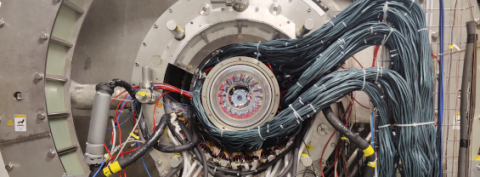In the search for New Physics at the Intensity Frontier: a first result from the MEG II experiment

The ultra-rare decay of a muon into a photon and a positron (or electron) has been searched for decades, shortly after the discovery of the muon itself and never observed so far, representing therefore a sort of Holy Grail in particle physics.
This process would violate the accidental symmetry of the muonic flavour conservation in the Standard Model theory of fundamental interactions (SM) and therefore its existence would shed light into physics beyond the SM itself. Many models trying to extend the SM are in fact predicting such a process.
In a special seminar at the Paul Scherrer Institut (PISI)in Switzerland, the MEG II Collaboration will present on Oct. 20th its first results about a new search for this process, based on data collected in 2021.
In the last years, the MEG II collaboration has built, commissioned and operated an experiment especially designed to look for this process. A joint INFN Roma and Sapienza group(G.Cavoto, F.Renga and C.Voena) is part of this collaboration since many years working - in particular - in the positron detector and in the data analysis.
The Standard Model is actually predicting that the muon could decay into a positron-photon pair, without neutrinos, but with an unmeasurably low probability. The current best exclusion limit on the existence of such decay is the level of a few units of 10-13 probability! An enormous number of muon decays is, therefore, necessary to hope to find this needle in a haystack.
In MEG II – an upgrade of the former MEG experiment – up to 50 billion muons from the most intense continuous muon beam in the world are stopped every second in a thin target at the center of a special gradient solenoidal magnet generated by superconducting coils. State-of-the-art particle detectors are used to trace down the decay products: an ultralight gaseous detector (a cylindrical drift chamber) and two matrices of plastic scintillating tiles are used to reconstruct the positron trajectory and its time, while photon detection relies on a 900-liter scintillating liquid-xenon detector.
The experiment is still taking data since 2021 and a twenty-fold increase in statistics is foreseen by 2026, with the goal to improve the sensitivity to the decay probability by one order of magnitude with respect to MEG.
The MEG II collaboration gathers together more than 50 physicists from Italy, Japan, Russia, Switzerland, UK and the USA. MEG II is supported, among other international
